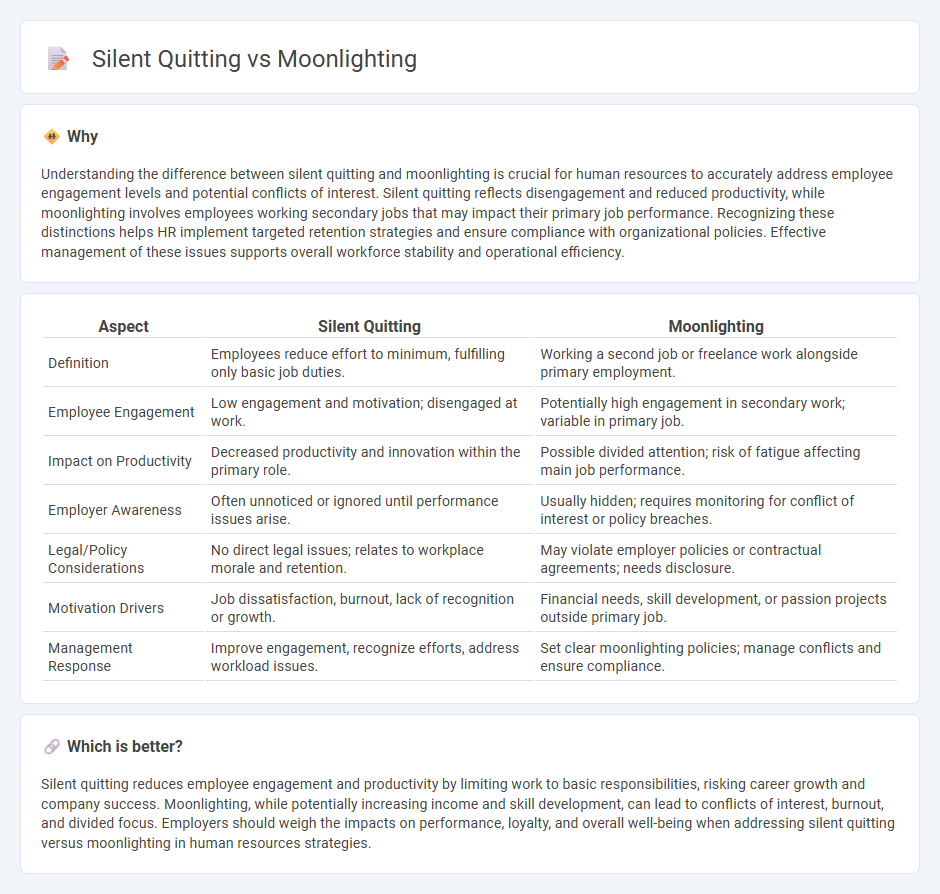
Silent quitting refers to employees doing the minimum required work without engaging beyond their job description, often due to burnout or lack of motivation. Moonlighting involves employees taking on a second job or side gig outside their primary employment, which can impact productivity and workplace commitment. Explore these concepts further to understand their implications on workforce management and employee wellbeing.
Why it is important
Understanding the difference between silent quitting and moonlighting is crucial for human resources to accurately address employee engagement levels and potential conflicts of interest. Silent quitting reflects disengagement and reduced productivity, while moonlighting involves employees working secondary jobs that may impact their primary job performance. Recognizing these distinctions helps HR implement targeted retention strategies and ensure compliance with organizational policies. Effective management of these issues supports overall workforce stability and operational efficiency.
Comparison Table
| Aspect | Silent Quitting | Moonlighting |
|---|---|---|
| Definition | Employees reduce effort to minimum, fulfilling only basic job duties. | Working a second job or freelance work alongside primary employment. |
| Employee Engagement | Low engagement and motivation; disengaged at work. | Potentially high engagement in secondary work; variable in primary job. |
| Impact on Productivity | Decreased productivity and innovation within the primary role. | Possible divided attention; risk of fatigue affecting main job performance. |
| Employer Awareness | Often unnoticed or ignored until performance issues arise. | Usually hidden; requires monitoring for conflict of interest or policy breaches. |
| Legal/Policy Considerations | No direct legal issues; relates to workplace morale and retention. | May violate employer policies or contractual agreements; needs disclosure. |
| Motivation Drivers | Job dissatisfaction, burnout, lack of recognition or growth. | Financial needs, skill development, or passion projects outside primary job. |
| Management Response | Improve engagement, recognize efforts, address workload issues. | Set clear moonlighting policies; manage conflicts and ensure compliance. |
Which is better?
Silent quitting reduces employee engagement and productivity by limiting work to basic responsibilities, risking career growth and company success. Moonlighting, while potentially increasing income and skill development, can lead to conflicts of interest, burnout, and divided focus. Employers should weigh the impacts on performance, loyalty, and overall well-being when addressing silent quitting versus moonlighting in human resources strategies.
Connection
Silent quitting often stems from employee disengagement, which can also drive individuals to pursue moonlighting as a way to fulfill unmet career goals or financial needs. Both behaviors reflect a growing disconnect between employees and employers, impacting productivity and workplace morale. Human Resources departments must address underlying causes by fostering engagement, transparent communication, and flexible work policies to mitigate risks associated with these trends.
Key Terms
Dual Employment
Moonlighting involves holding a second job in addition to a primary employment, often to increase income or explore different career interests, while silent quitting refers to employees doing the bare minimum at their primary job without officially resigning. Dual employment raises concerns about conflicts of interest, time management, and employer policies, whereas silent quitting impacts productivity and workplace morale without any contractual breach. Explore more about balancing dual employment and workplace engagement to optimize career growth and job satisfaction.
Disengagement
Moonlighting involves employees taking on additional jobs outside their primary employment, often indicating disengagement through divided attention and reduced commitment to their main role. Silent quitting reflects a disengagement strategy where employees do only the minimum required work, avoiding extra tasks or involvement, signaling a decline in motivation and connection to their organization. Explore further insights on how these behaviors impact workplace productivity and employee well-being.
Workplace Productivity
Moonlighting, involving employees working a second job alongside their primary employment, can lead to decreased workplace productivity due to divided attention and increased fatigue. Silent quitting, characterized by employees doing only the minimum required work without engagement or extra effort, significantly reduces overall team output and morale. Explore the impact of these behaviors on organizational efficiency and strategies to address them.
Source and External Links
MOONLIGHTING definition | Cambridge English Dictionary - Moonlighting is the act of working an extra job, especially without informing your main employer, sometimes requiring approval to avoid job loss.
moonlighting | Wex | US Law | LII / Legal Information Institute - Moonlighting refers to holding more than one job at the same time, typically a second job outside normal working hours, which may be forbidden by some employers due to conflict of interest concerns.
Moonlighting (TV series) - Wikipedia - *Moonlighting* is an American comedy-drama TV series that aired from 1985 to 1989, starring Cybill Shepherd and Bruce Willis as private detectives in a show blending humor, mystery, and romance.
 dowidth.com
dowidth.com